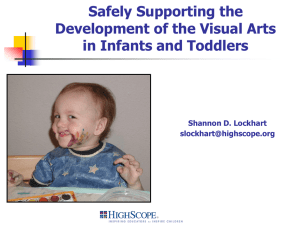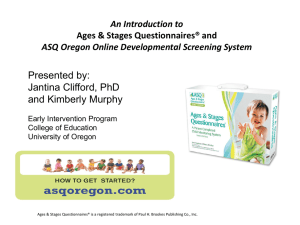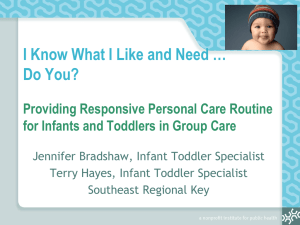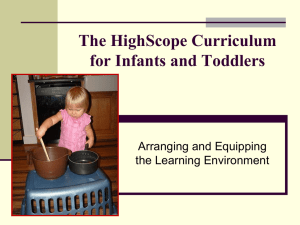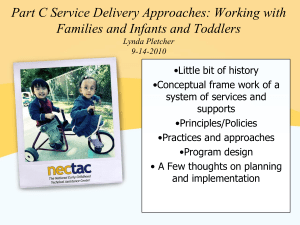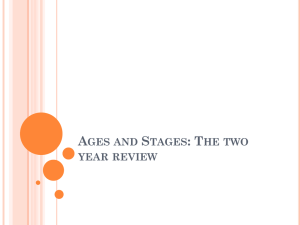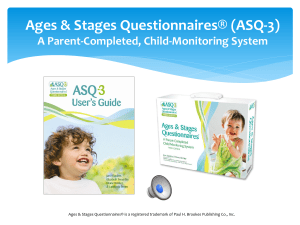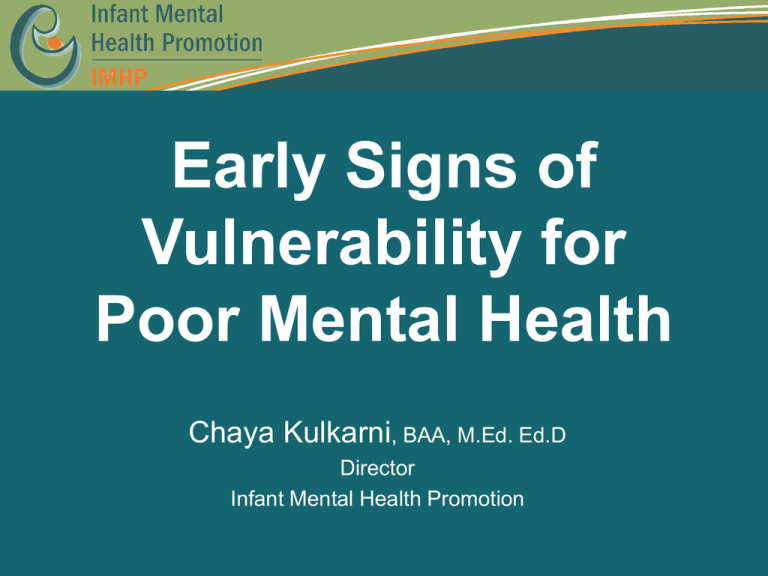
Early Signs of
Vulnerability for
Poor Mental Health
Chaya Kulkarni, BAA, M.Ed. Ed.D
Director
Infant Mental Health Promotion
Why Am I Here?
Maybe you think you are in the wrong session
Director of Infant Mental Health
•
•
•
•
Was every other session full?
How is this connected to kids in school?
How can this possibly have anything useful for me?
Infants can’t possibly have mental health what is she going
to talk about for the next hour?
Dispelling the Myths About
Infants and Toddlers
Myth #1
Infants don’t have mental health
Do infants show emotions?
Do infants, even young
infants, respond to comfort?
Do infants respond to people?
The truth is…..
Infants are born with mental health – it will
continue to develop throughout their life
Myth #2
Infants won’t remember the negative
experiences they have early in life including
the emotional ones.
The truth is…
Infants are born relationship ready
The relationships they have give them
experiences that will in fact shape the
architecture of their brain
The experience an infant has early in life is wired
into his/her brain and will impact his/her
development throughout their life.
Myth #3
Infants are resilient and will easily recover
from early adversity.
The truth is….
While children are resilient, there is a threshold.
When infants experience prolonged and frequent
trauma their ability to “bounce back” to be
resilient will reach its limits.
Exposure to frequent and prolonged stress will
impact brain development.
Myth #4
Early experiences don’t really count –
it’s what happens when they start school that
really matters.
The truth is…
The brain develops rapidly in the first three years
of life forming 700 new neural connections
every second – that would be before school
The greater the number of adverse experiences a
very young child has the more likely his/her
development will be impacted
Myth #5
It is not possible to recognize poor mental
health during infancy.
The truth is…..
There are behaviors that do tell us when a child is
experiencing poor mental health – but we need
to know what these look like.
We have access to various tools referred to as
screening tools that can help us know when a
child needs a more in-depth assessment from
a clinician. These will not diagnose but they
will tell us a child needs more assessment.
Myth #6
Infants and toddlers who experience neglect
and/or abuse are getting the help they need
to address their mental health needs.
The truth is…..
Very little is done to monitor a young child’s
development overall much less their mental
health.
Other jurisdictions are screening for development
including early mental health.
Myth #7
Early mental health does not impact mental
health later in life.
The truth is
The greater the number
of early adverse
experiences a child has
the more likely s/he will
experience adversity
throughout his/her life.
Myth 8
Whatever adversity a child may have
experienced before school can be undone by
the programs offered to him/her.
The truth is….
A child who arrives at school with poor mental
health is likely already behind. The gap in
developmental outcomes and achievement will
continue to increase over time. To change this
will require MONUMENTAL resources from the
system and the child.
When Children Arrive at School
A concern may be expressed about that child’s
behavior.
Sometimes the concerning behavior is distressing
all in the classroom – teacher, other children…
That child’s behaviour did not happen when he
arrived at school.
That child has been on a journey that brought him
to that place.
While We Can’t Change
the Past
There are many things that those in the school
system can do to support early mental heath.
We can screen for early mental health in our
classrooms.
We can create plans that can be used by
teachers, parents and other resource workers
in the classroom to support a child’s social
emotional development.
But this is major change….
This is about changing:
• Our knowledge about mental health
• Our policies around early identification of mental
health vulnerability
• Our practices supporting early mental health.
• Our beliefs about mental health – when it begins
and what influences.
Infants and toddlers are missing
from the picture
While there has been an important and impactful
effort to raise awareness about mental health
these efforts have focused on youth and adults
suffering
Most people do not realize that for too many, poor
mental health begins during the first three
years and sets a child on path that can be
riddled with mental health challenges
Your Context….
Many of you see children when they are on
the verge or immersed in a mental health
crisis.
They are being labeled by others in the
system, by their peers, by other parents.
They are at a VERY HIGH risk for a life time of
poor outcomes physically, emotionally and
cognitively
Waiting is not a solution
We can begin to work with families to:
• Understand the mental health needs of their
child
• Create plans that will begin to deal with any
vulnerabilities. These plans can be used by the
teacher, the parents and any other resource
staff working with the child
• Monitor regularly the child’s development
This is not about academic testing but this
will impact academic outcomes for a child
An Overview of Early
Mental Health
Does it really exist?
My Objectives for Today
To enhance your knowledge of early mental
health – how it develops, what influences it
To enhance your practices with young children
so that we create opportunities for those in the
system to understand each child’s mental
health
To identify opportunities to create policies that
will enable you to support the mental health of
TDSB’s youngest pupil
What is early mental health?
Early mental health is the social, emotional &
cognitive well being of infants and toddlers
When does mental
health begin?
– A child’s mental health begins at conception
– An infant, toddler, preschooler or kindergarten child
can have serious mental health and emotional
problems
– An infant who experiences poor mental health this
early in life, will be vulnerable for poor mental health
throughout life
Definitions of trauma
Trauma can be the result of:
• Community violence
• Family violence
• Child maltreatment
Community Violence
• Violence outside the home, within the
neighborhood
• Violence committed by people who are not
known or related to the child
• Exposure to weapons, muggings, the sound of
bullets, sexual assaults
• Contact with gangs and guns
• Being a victim of violence
Summers & Fitzgerald. (2012). Understanding early childhood mental health. United States:
Brookes Publishing.
Family Violence
• Violence within the home
• Violence between family members
Summers & Fitzgerald. (2012). Understanding early childhood mental health. United States:
Brookes Publishing.
Child Maltreatment
• Physical abuse, sexual abuse, emotional
abuse, neglect
• Physical abuse includes non-accidental act as
that result in injury to a child
• Neglect includes absence of care by
caregivers, failure to supervise young children,
or failure to provide for the basic needs of
children
Summers & Fitzgerald. (2012). Understanding early childhood mental health. United States:
Brookes Publishing.
But can young children
experience trauma symptoms?
Yes they most certainly can.
For example, in a study by G. Anne Bogat , Erika
DeJonghe, Alytia A. Levendosky, William S.
Davidson, Alexander von Eye (September
2005) it was concluded that “infants as young
as 1-year-old can experience trauma
symptoms as a result of hearing or witnessing
IPV.” www.msu.edu/~mis/publish/Infant_Trauma.pdf
Definitions Will Vary
For our purposes we define trauma as:
“…an event or events that involve actual or
threatened death or serious injury to the child
or others, or a threat to the psychological or
physical integrity of the child or others”
Zero to Three, National Centre for Infants, Toddlers and Families. (2005). Diagnositic classification of mental health and
developmental disorders of infancy and early childhood, revised (DC: 0-3R). Washington, DC: Zero to Three.
Exposure to trauma can occur once or multiple
times, and young children exposed to multiple
traumatic events tend to experience worse
outcomes than those exposed only once.”
Chu, A.T., & Lieberman,j A.F. (2010). Clinical implications of traumatic stress from birth to age five.
Annual Review of clinical Psychology, 6, 469-494.
Early is Essential
There is a strong link between children’s trauma symptoms and the
amount of exposure a child has had to traumatic events.
The longer and more often a child is exposed to violence, the worse
off the child will be socially, emotionally, and psychologically in the
long run.
Interventions and supports must address both immediate needs and
long-term development and relationship issues.
The longer we wait to recognize and respond the more likely the
impact on a child’s development will be negative
What is the impact of early trauma?
Early trauma
• affects a young child’s development, behavior and
relationships
• brain development
• when undetected and untreated, will impact short and
long term mental and physical health outcomes
• Is much harder to recover from the longer it continues
undetected and untreated
• Often leads to prolonged and frequent stress for the
child
For these reasons, early detection and early
intervention are critical for young children
Trauma Symptoms in Young Children
•“Re-experiencing” or playing out
memories of the event
•Toileting problems
•Sleep problems
•Eating problems
•Verbal or language difficulties
•Developmental regression
•Withdrawal
•Onset of new fears
•Aggressive outbursts or
increased activity level
•Increased clinginess/separation
•Anxiety
•PTSD
•Relationship problems –
including poor attachment or
attachment disorders
•Depression
•Dysregulation of stress system
•Low self-esteem
•Preoccupation with the traumatic
event such as bringing up the
episode repeatedly or
uncontrollably
•Increased and prolonged stress
Toxic Stress & Brain Development
Toxic stress is the frequent, prolonged activation
of the stress response system
Triggers the release of chemicals that impair
brain development and functioning
World wide data on the lifelong implications of
stress in early childhood
When a child is vulnerable to continued exposure
to any of these experiences they are more
likely to be traumatized
At the time of the trauma the protective factors
surrounding a child may help a child overcome
and recover from the event
But for too many infants and toddlers those
factors are not consistently present in their lives
Traumatic
events/experiences
One parent is an
abuser
Parental death
Second parent
removes child
and her/himself
from the
situation
Other family
members step in
and provide the
response the
baby needs
Parent accesses
support
Protective Factors that may
mitigate minimize impact
Baby or Toddler who has
recovered from traumatic
experience/event
Traumatic
events/experiences
Mother dies
Limited/weak
Protective
Factors
Baby or Toddler unable to
recover from trauma
Infant or Toddler suffering from
poor mental health
Father
emotionally
vulnerable/
no one else to
respond
(examples)
Trauma
Stress
Brain
development
Overall
development
Relationship/
attachment
Overall
health
Why Do We Make
Reasoning Errors?
Emotional reasons
Cognitive reasons
Common Errors in Reasoning
Halo effect
Filtering or confirmation bias (Munro)
Desensitization & depersonalization
Allure of available or vivid evidence
Vanity effect
Perseverance effect
Imposing meaning or causality
Cause & Effect Error
How Can We Improve Practice?
Accept that we are worse at making decisions
than we think we are
Train practitioners to be comfortable with
dissonant views
Train practitioners to use empirical evidence
correctly
Encourage reflective supervision
Create feedback mechanisms
Your role in understanding a
child’s development
Depending on your role you may or may not be
able to diagnose
You can implement a developmental screen
either in partnership with the biological family,
the foster family, through your own
observations or a combination of any two of the
above
You can be trained on how to implement both a
screen and curriculum based assessment tool
Your role in understanding a
child’s development
You can reach out to community agencies such
as Early Years Centres, children’s mental
health agencies and ask for guidance with the
creation of a developmental plan to support the
needs of a child
You can refer parents to programs in the
community that provide guidance around
parenting and supporting development
Poor Mental Health Can Impact Health
Outcomes – Short and Long Term
We know that when young
children experience poor
mental health the impact is
also on their physical health
and well being
According to researchers at
Harvard, children who
experience poor mental health
experience higher rates of
illnesses throughout life.
Health Outcomes:
Physiological /Medical Challenges
– You can be the FIRST RESPONDER
– You cannot diagnose
– You can make referrals to the appropriate
professional who can diagnose
– You can be making observations that can be shared
with other professionals (with parental consent) that
could be very helpful – for instance, a child with poor
muscle tone making observations of movements, any
pain the child experiences etc… can be helpful to a
clinician
– You can be reviewing medical records
– You can be consulting with/to the other disciplines
involved with the case (with the appropriate consents)
Historically
what has neglect/abuse looked like?
A baby with broken bones
A toddler with healing fractures and other
unexplained injuries
An underweight infant
An unkempt, dirty toddler
A baby who has been shaken within inches of
his/her life
This is what we all looked for and when these
things were absent we often thought all was
okay
We are good at looking for
hazards
Typically, when concerned we look for the
hazards.
But where the mental health of young child is
concerned the absence of “normal things,
experiences” should be as concerning to us as
the hazards that are present – the absence of a
warm blanket in the toddlers crib during winter
needs to be a concern
We know much more…
Neglect and
maltreatment lead
to poor mental
health for infants
Emotional Deprivation in Infancy :
Study by Rene A. Spitz, 1952
http://www.youtube.com/watch?v=VvdOe10vrs4
What Does all of this Mean?
1. The Absence of Normal Can’t Be Ignored
2. Monitor the child’s development and provide
activities to support development while he is
involved with your agency
3. Connections Count - Be connected to resources
and professionals who can step in with the
expertise you don’t have.
4. Be aware of the interventions that are available to
your agency and therefore the children.
5. Educate, Educate, Educate!!! The Judge, The
Lawyers, Your Team
6. Advocate for babies and toddlers as a unique
group with unique needs
Development Counts but
Who is Watching?
“Developmental structures are incorporated into
later developmental structures, so that early
competence tends to foster later competence,
and early incompetence tends to promote later
incompetence” (Cicchetti & Cohen, 1995; Waters & Sroufe, 1983)
If this is the case how is that we don’t monitor
development and respond to what a child
needs?
Monitor Development
In the US every child under the age of three is
entitled to a developmental screening and
service plan.
Monitoring development is not difficult – IMHP will
gladly train you and your team to do this!
Create a developmental plan that can be shared
with those caring for the child. This ensures
some consistency of expectations and also
supports the child’s development appropriately
Do Screen for Development
You can screen for development including mental
health using tools such as (but not limited to):
• ASQ 3
• ASQ SE
• Brief Infant-Toddler Social Emotional
Assessment (BITSEA)
• Eyberg Child Behavior Inventory
• Vineland Social-Emotional Early Childhood
Scales
Make Use of What Might
Be Dead Time
With the resources available you can be a bridge
to the services and supports a child and family
may need.
Make the appropriate referrals.
While waiting for services to kick in, create a plan
that supports the child’s development and gives
caregivers something to focus on.
What is ASQ:SE?
Parent- or caregiver-completed screening tool
that encourages parental/caregiver
involvement
Series of questionnaires for children ages 3
months to 5 ½ years
Tool to accurately identify children at risk for
social-emotional delay
ASQ-3™ and ASQ:SE Training Materials by Jane Squires, Jane Farrell, Jantina Clifford, Suzanne Yockelson, and Elizabeth Twombly
Copyright © 2010 Paul H. Brookes Publishing Co. All rights reserved. www.agesand stages.com
Domains on ASQ:SE and
Ages & Stages Questionnaires® (ASQ-3™)
ASQ:SE
– Social-emotional development
ASQ-3
(screens 5 domains)
– Communication
– Gross motor
– Fine motor
– Problem solving
– Personal-social
ASQ-3™ and ASQ:SE Training Materials by Jane Squires, Jane Farrell, Jantina Clifford, Suzanne Yockelson, and Elizabeth Twombly
Copyright © 2010 Paul H. Brookes Publishing Co. All rights reserved. www.agesand stages.com
Types of Assessment
Screening assessment
Diagnostic assessment
Curriculum-based
(programmatic, ongoing)
assessment
ASQ-3™ and ASQ:SE Training Materials by Jane Squires, Jane Farrell, Jantina Clifford, Suzanne Yockelson, and Elizabeth Twombly
Copyright © 2010 Paul H. Brookes Publishing Co. All rights reserved. www.agesand stages.com
Screening
Above Cutoff
Professional
Assessment
Eligible
Not Eligible
Near Cutoff
Well below cutoff
Continue to Monitor
(Re-Screen) & use
Curriculum-Based
Assessment to develop
learning plans
ASQ-3™ and ASQ:SE Training Materials by Jane Squires, Jane Farrell, Jantina Clifford, Suzanne Yockelson, and Elizabeth Twombly
Copyright © 2010 Paul H. Brookes Publishing Co. All rights reserved. www.agesand stages.com
Why Screen Social-Emotional
Development?
In the US Part C of IDEA calls for the social-emotional
area to be assessed and services provided if
necessary
Programs such as Head Start mandate that this area be
addressed in their performance standards
Links to early social emotional behaviors and subsequent
outcomes
In Ontario we don’t have a “Part C” so what happens will
vary across the Province
ASQ-3™ and ASQ:SE Training Materials by Jane Squires, Jane Farrell, Jantina Clifford, Suzanne Yockelson, and Elizabeth Twombly
Copyright © 2010 Paul H. Brookes Publishing Co. All rights reserved. www.agesand stages.com
Why Screen Social-Emotional
Development?
Links exist between earliest emotional
development and later social behavior (Cicchetti &
Cohen, 1995a, 1995b; Reynolds, Temple, Robertson, & Mann,
2001)
Behaviors, even in infancy, signal the need for
intervention (Shonkoff & Phillips, 2000)
Links exist between early risk factors, poor
outcomes, and violence (Conroy & Brown, 2004)
By 3rd grade, programs for children with
antisocial behavior are mostly ineffective
(Greenberg et al., 2003; Walker, 2004)
ASQ-3™ and ASQ:SE Training Materials by Jane Squires, Jane Farrell, Jantina Clifford, Suzanne Yockelson, and Elizabeth Twombly
Copyright © 2010 Paul H. Brookes Publishing Co. All rights reserved. www.agesand stages.com
ASQ-3
Ages and Stages – 3
Questionnaire
ASQ:SE
Ages and Stages: SocialEmotional Questionnaire
Developmental Program Plans
Connections Count
You can’t be all things to all children and their
families – so who else can step in?
Have your school update their list of resources –
there may be new programs that you are not
aware of.
Connect to programs such as ECE who may be
able to provide students who can provide some
developmental guidance to some children.
When Intervening Do it Early
and Generously
As mentioned early intervention is paramount if
you want to have an impact that will change a
child’s developmental trajectory
Provide interventions and supports generously.
Parenting is hard for most of us. For those
struggling, the support they may need to make
the changes the child needs may require
significant supports – early is best and be
generous if you are serious
Look at Your Agency
• Does your agency have best practice
guidelines in place specific to infants and
toddlers?
Educate! Educate! Educate!
IMHP will be creating a brief that will be available
to agencies and will provide salient points to
share with Judges and others.
Other training resources will also be developed
Including:
•
•
•
•
Training curricula and modules for Child Welfare
Developmental Program Planning Worksheets
Temperament training and resources
Infant Mental Health Resources

